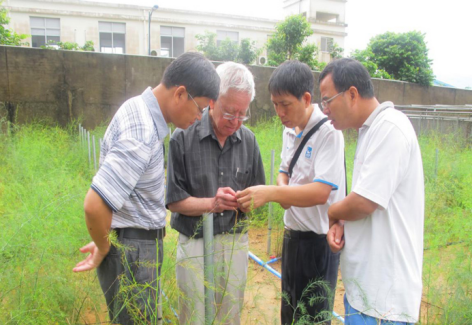At the invitation of the Fibers and Asparagus Research Group under TBBRI, Prof. Che Che-Kok Chin came to TBBRI for academic exchanges and gave three presentations on September 21 and 22. Prof Chin is the former director of the Department of Plant Biology and Pathology, Rutgers University, New Jersey of the USA,
China is the world's largest grower and exporter of asparagus pea. Surpricingly asparagus pea not only frequently appears on the menus of state banquets entertaining foreign state leaders like those participating to recent G20 summit in Hangzhou, but also on the menus of many common families due to their affordability and preference as well as health’s concerns. It is believed that asparagus pea industry ushers in a new opportunity for development. For the autumn and winter seasons, North China and South Korea and Japan and other countries need temperature compensating cultivation for asparagus peas, which result in higher cost of asparagus pea production. Therefore a large number of asparagus pea growers shift to Hainan for natural temperature endowment. But typhoon and abundant rain in Hainan caused the outbreak of stem blight disease (quasi important fungal disease caused by Phomopsis asparagi, commonly known as asparagus cancer), which hampers the asparagus pea industry development in Hainan. Under this background, Prof Chee-Kok Chin just came at the right time.
In his first presentation Professor Chin introduced the methods of cultivating holandric asparagus pea varieties. Mutation breeding methods were briefed in his second presentation, which included the callus culture, chemical treatment, then scattered cells which would be induced with physical and chemical methods. Then, the above induced cells were treated with biological adversity or abiotic stress. The surviving cells received further culture to form calli and plantlets which were treated with biological adversity or abiotic stress to obtain desirable varieties. No chimera exist by this method. In his third presentation, Professor Chin highlighted the role of lipids in signal transduction, and as the yeast delta 9 desaturase genes were transformed into plant which would resist several kinds of pathogenic bacteria of phytophthora.
After that, the asparagus pea team and professor Chin went to asparagus pea growing area in Hainan and answered questions from farmers.
The Chee - Kok Chin is famous for asparagus pea breeding in the world and has breed a lot of varieties of asparagus pea which are planted in many country.
China is the world's largest grower and exporter of asparagus pea. Surpricingly asparagus pea not only frequently appears on the menus of state banquets entertaining foreign state leaders like those participating to recent G20 summit in Hangzhou, but also on the menus of many common families due to their affordability and preference as well as health’s concerns. It is believed that asparagus pea industry ushers in a new opportunity for development. For the autumn and winter seasons, North China and South Korea and Japan and other countries need temperature compensating cultivation for asparagus peas, which result in higher cost of asparagus pea production. Therefore a large number of asparagus pea growers shift to Hainan for natural temperature endowment. But typhoon and abundant rain in Hainan caused the outbreak of stem blight disease (quasi important fungal disease caused by Phomopsis asparagi, commonly known as asparagus cancer), which hampers the asparagus pea industry development in Hainan. Under this background, Prof Chee-Kok Chin just came at the right time.
In his first presentation Professor Chin introduced the methods of cultivating holandric asparagus pea varieties. Mutation breeding methods were briefed in his second presentation, which included the callus culture, chemical treatment, then scattered cells which would be induced with physical and chemical methods. Then, the above induced cells were treated with biological adversity or abiotic stress. The surviving cells received further culture to form calli and plantlets which were treated with biological adversity or abiotic stress to obtain desirable varieties. No chimera exist by this method. In his third presentation, Professor Chin highlighted the role of lipids in signal transduction, and as the yeast delta 9 desaturase genes were transformed into plant which would resist several kinds of pathogenic bacteria of phytophthora.
After that, the asparagus pea team and professor Chin went to asparagus pea growing area in Hainan and answered questions from farmers.
The Chee - Kok Chin is famous for asparagus pea breeding in the world and has breed a lot of varieties of asparagus pea which are planted in many country.

on-site research


